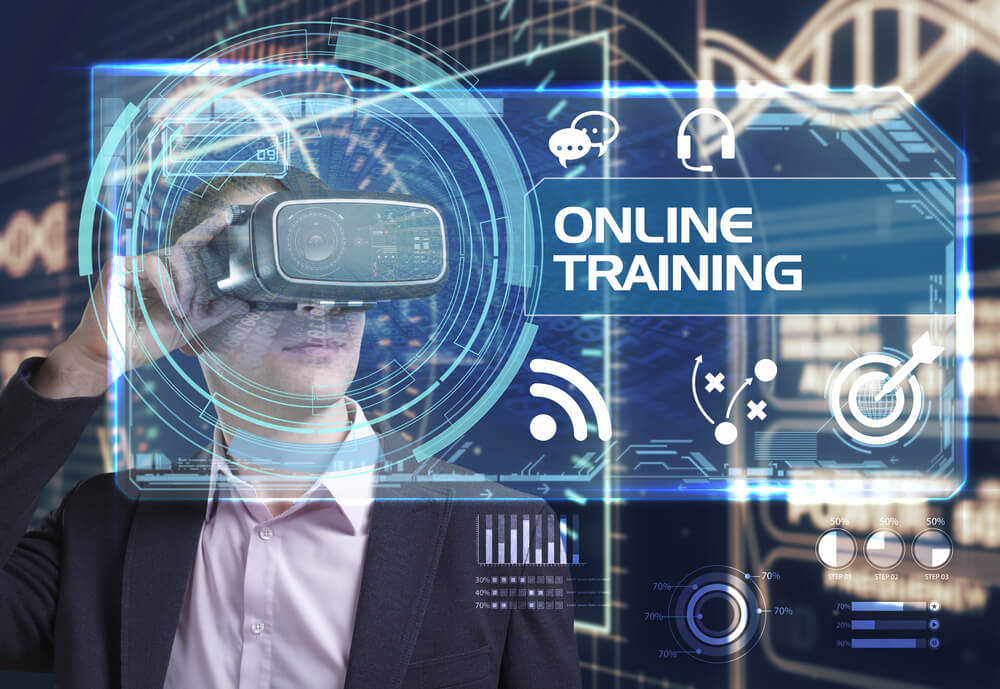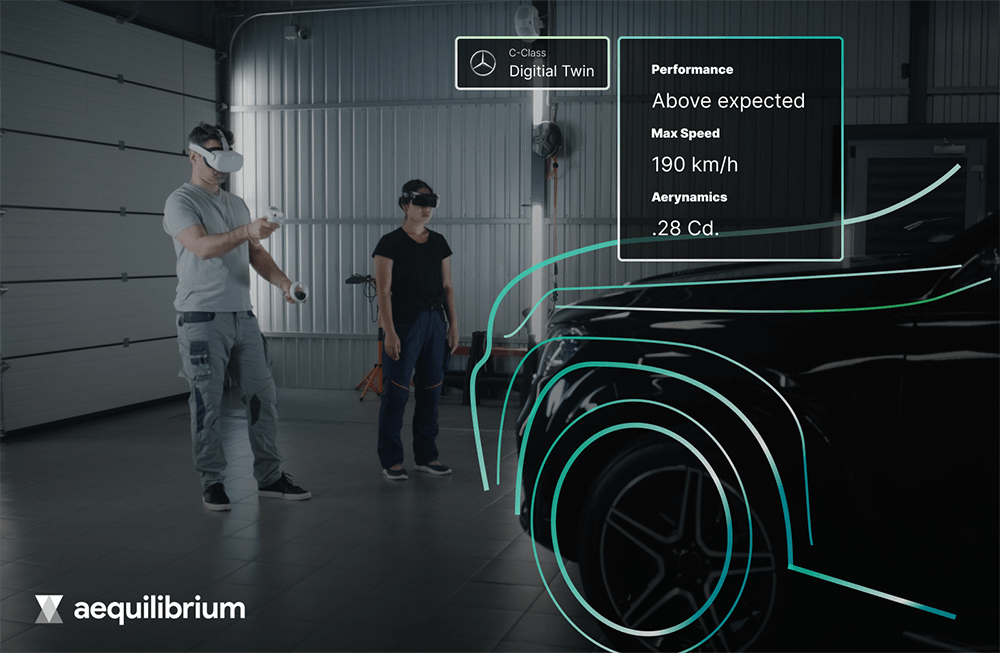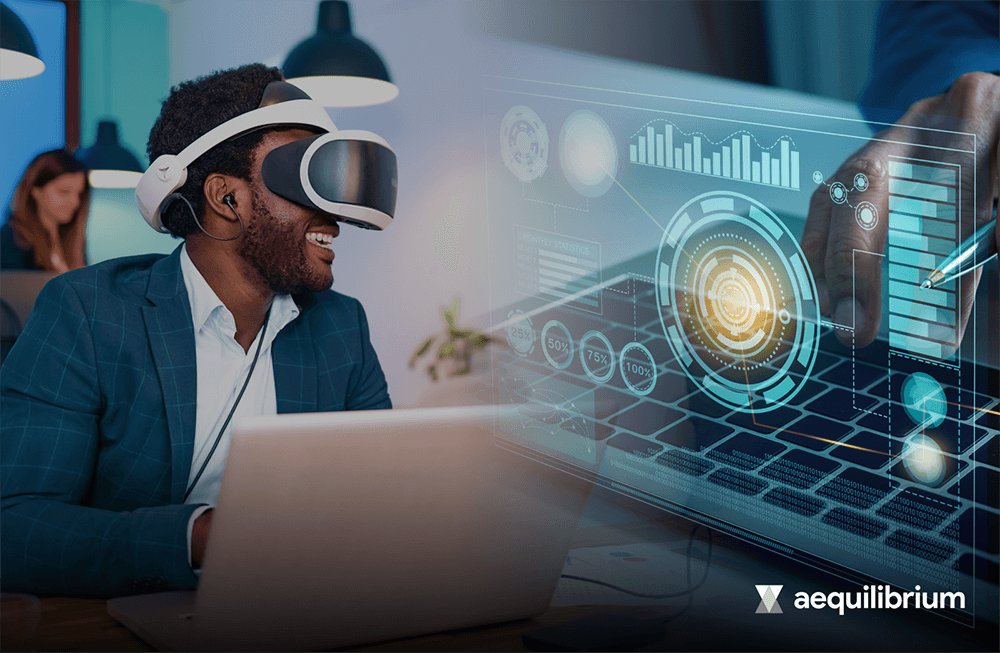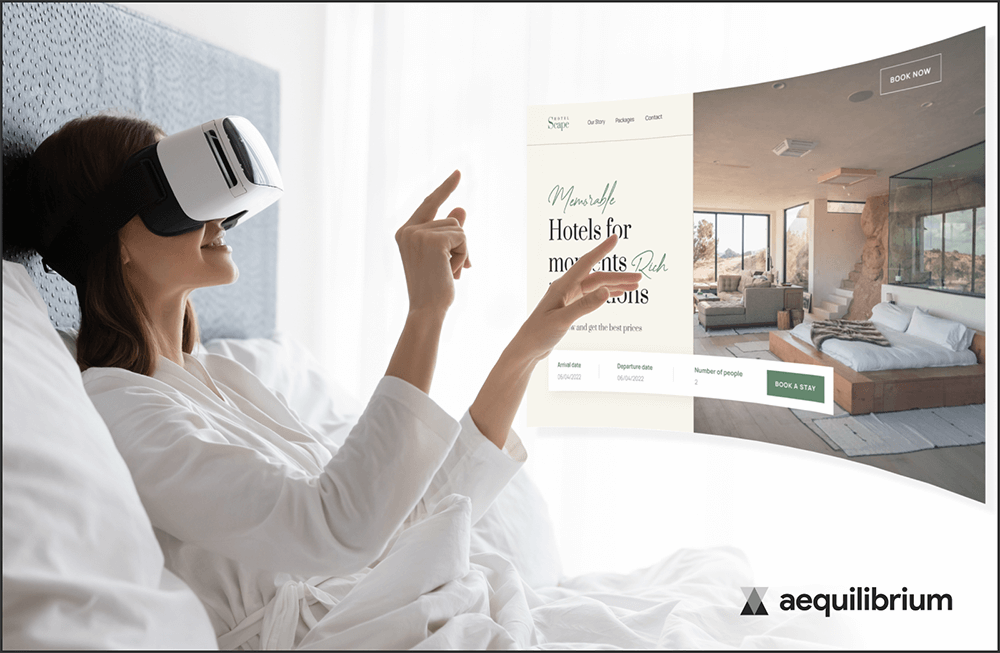In Part I of this article we come across the introduction to XR and the metaverse, an overview of the benefits of using XR for training, and examples from various industries. In part II, we have focused on progressive companies that are using XR to revolutionize training in healthcare, financial services, automotive, aerospace, and hospitality industries.
Impact of XR Training Across Industries

Healthcare
As people set out to explore the globe, the world becomes a smaller place. Yet, the other universe inside the human body stays as a mystery painted with imagination. With the onset of XR in the healthcare domain, people can explore the human anatomy with minimal risk.
During the global Pandemic, when doctors were not physically able to examine their patients, they did so virtually over symptoms, photographs, and video calls. This indeed opened the pathway for healthcare to go beyond physical presence. In 2022, studies show that XR training in medical science can help doctors to learn more about the human body, medical processes, and operation techniques by locating organs and diseases with ease.
To answer the question, Is the healthcare industry spearheading the metaverse? the answer would be yes!
Metaverse has been regarded as “the next horizon” in healthcare, with 80% of healthcare executives expecting the metaverse to have a positive impact on healthcare. Substantial training is required to make doctors and surgeons ready in the virtual space to treat and operate on their patients. They will have the power of exploring human physiology better than ever and have the benefit of working together with collective inputs in a connected network with deep collaboration.
The success of VR technology in healthcare came to light when for the first time in the history of time, surgeons across the globe came together in a virtual room and operated on the Brazilian conjoined twins and gave them separate entities. Bernardo and Arthur Lima had seven surgeries at the age of three and the final one involved 27 hours of operating time with almost 100 medical staff.
In the real world of medicine, the chances of training directly over living people is risky. The metaverse helps people with an immersive experience by porting them to a realistic virtual world. Studies show that VR-trained students perform faster, better, and more accurately while performing surgical procedures. Hand and eye coordination get enhanced with practical simulation-based education.
It also allows experiential ventures and collaborative learning in risk-free clinical situations. This method of the future provides surgeons a ground to practice while taking each step of surgical procedures and also assists in performing real-time highly complex surgeries. The results from CT scans and angiograms can be transformed into three-dimensional models for surgeons during operations to locate the area of interest and work on the same.
It is also worth mentioning the health and wellness sector, where people around the world try to pick nurturing their mind, body, and soul as their prime new year’s resolution. The global lockdown has impacted the lives of people in several ways. The change in the routine life had given rise to physical and emotional disorders. Gyms and training centers were closed down and people not only missed out on their fitness training but also on their social involvement in exercising together.
As an alternative, people started meeting over video conference calls to keep the collaborative effort going on. The introduction of the concept of VR fitness, not only offered people the experience of turning any place into a workout zone but also made multiple people work out together in the same virtual space.
Trainers would assist people alone or as a group from all over the world to help achieve their fitness goals. The new way to sweat out using VR is a milestone in making people happy and healthy at the same time.
Automotive
I have a personal fondness for cars and to witness technology merging with reality is much more exciting. The role of XR in the automotive industry is immense (Refer to Image 1). We all have experienced some glimpses of the future of automobiles with exciting new features and possibilities in science fiction for the last few decades. Now is the time to witness how fiction turns into reality. In this industry, VR is used extensively for training, designing products, technical services, maintenance, and innovation.

Image 1: XR in Automotive Industry
All the progressive automotive companies are embracing XR to design the future of automotive with cutting-edge technology and innovation. The vast training opportunity in this space is driven by virtual access to vehicles, machines, and tools. Users can get trained by being in various challenging and unexpected scenarios virtually without the risk of any actual danger.
Employees can collaborate through VR platforms and work on life-size 3D models to enhance the product or design the best solutions.
The Volkswagen Group, in the Shanghai Automotive Industry Corporation (SAIC) plant, have made it possible for employees to replace their safety glasses with AR and VR glasses. The risk factor is being replaced by technology and innovation. They implement innovative training processes for employees in their production lines and logistics department using virtual reality that replicates real-world scenarios.
Ford has virtual labs in which engineers, developers, and designers across locations come together to design cars. They use motion sensors to capture the interactions of users and drivers with their vehicles. Ford has gone to the next level to enhance the comfort of customers by letting them experience the car via apps. Shifting to the virtual space has reduced the risks of injuries during work or training. Therefore, the absence of employees from work due to injury has also been reduced by 75 percent.
BMW used AR in their designing stage to assess prototypes in collaborative platforms using multi-user mode before starting their production to ensure that the vehicles produced to meet the required standards. They use overlays with holographic 3D models to assess the dimensions making the process of testing and production cost-effective. This also showcases the scope of training their employees remotely by accessing prototypes in a realistic environment.
Mercedes Benz uses AR in their services and plans to provide sales training over the same to address areas like customer experience, vehicle repair, and maintenance. They also use Microsoft HoloLens to provide repair services yielding faster results and better efficiency.
Toyota uses virtual reality and augmented reality glasses in their production and service lines to gain knowledge and train employees on how to assemble or repair automotive parts. Their design departments use prototype models in AR and VR to scale the product to its real size and test them virtually before the physical versions are created.
Porsche uses AR technology to service cars by getting into a virtual hurdle. As per their estimation, AR service technicians solve problems 40 percent faster by reaching out to remote experts for help. Similarly, maintenance is enhanced by making better decisions through remote consultation with fellow workers to craft faster solutions.
Aerospace
American action film Top Gun: Maverick, 2022 is a fictional story that provides a sneak peek of today’s aerospace. It showcases simulated pilot training where the trainees learn through immersive experiences about the mission and vision of the project that they were in. We are in an era when the narrow line between fiction and reality is gradually merging.
Currently, in aerospace, workers are trained extensively in the virtual world, before they step into the actual process. AR and VR technologies are significantly used in aerospace to manufacture, design, and to train workers on applications directly. Trainees can learn through simulations and face real scenarios, without navigating through manuals or videos for fishing out solutions. Through simulation, instructions are provided for flights, repair and maintenance, manufacturing, and for other functional outcomes. Simulators can be deployed remotely with the help of display screens and trainees can gain knowledge of highly dangerous training with zero risk.
The feeling of being in a plane and flying through, without actually being in one is an experience of a kind. The aviation and manufacturing space are using VR technology in its designing process to create virtual prototypes. For example, designing and testing aircraft models virtually before manufacturing it can save the risk of both time and money investments. Customers can experience an immersive feel of the cabin space, look out for the different views from their seats and approaching their destination, and also get an overall idea to share feedback. The feedback enhances the experience, which can drive modifications to the design in a timely and cost-effective way.
VR is boosting growth in the defense market aerospace, with investments in millions. Structures of aircraft are designed using 3D models to ensure better quality and to reduce risks in the defense domain by manufacturing aircraft with productive designs. Usage of VR technology allows engineers to optimize plans and processes and they are also provided with training to deliver better results. Using VR glasses warplanes are monitored part by part, obstacles are artificially created to formulate defense plans, and valuable insights are achieved through real-time monitoring of activities and spaces.
Finance
Banking and money-related transactions often build vulnerable experiences for customers. Banking involves sensitivity and accuracy during training. Infusing empathy and immersive training can lead to better service delivery, and higher levels of consumer trust and retention, especially during salient moments where important financial decisions are being made, and emotions are high.
Here are a few examples of how leaders in financial services embrace the remote workforce and come up with effective and novel training solutions for their staff.
Employee Training at Bank of America
Bank of America started a pilot with Strivr to train 400 employees in VR. Scaling this out would allow 50,000 employees to practice a range of routine to complex tasks. Simulate client interactions, operating under pressure/bank robbery, fraud detection, notary services, and sensitive matters like the death of a relative. Their hypothesis was that they will see increased learning retention because the immersive, multisensory experience fully captures an individual’s attention (Refer to Image 2).

Image 2: XR in Finance Industry
South Korea’s KB Bank unveils a Metaverse Bank Testbed
Kookmin Bank partnered with VR content developer Sharebox to construct the virtual branch. KB plans to train employees and teach young adults about finance using the virtual reality branch of the metaverse. Simple transactions, such as remittances, can be managed at a teller window, while an employee avatar inside the virtual VIP lounge can help clients analyze risk-return profiles or design investment portfolios. Inside the main hall, customers can also browse their personalized financial information.
HPE Financial Services is using Virtual Reality for Sales Training
VR can help managers evaluate employees’ current skill levels for different key competencies, enabling them to more effectively allocate training resources and match skill profiles to job functions. For example, HPE Financial Services has provided VR training for their sales reps before they got in front of their valued, high-level customers.
So they ran a pilot VR solution with 340 sales reps, in which the reps each conducted a 30-minute role play exercise with an avatar designed to simulate a C-level customer, and then receive feedback on areas for improvement. With the rise of remote working, more companies will be looking for innovative ways to deliver learning solutions.
Hospitality
VR can inspire and emotionally move people, and immerse customers in a virtual environment with realistic sounds and sights, giving them a low-cost/low effort/low-risk way to try a destination out for themselves before they agree to invest in the real travel plan. (Refer to Image 3)
XR can go a long way to make a particular destination or marketer stand out from a homogenous crowd where competition is fierce and margins relatively thin. Research also backs this up. For example, research conducted in Germany by Statista found that 49% of people would be willing to use VR for choosing their next holiday destination if they could avail of this option for free and 13% would be willing to pay for it. Imagine if you could show your clients the exact destination they were dreaming of, ranging from the quiet white sand beach to the photorealistic sunset that they can experience from the balcony of their hotel room.

Image 3: XR in Hospitality Industry
The scope of VR is extensive in training employees in the hospitality sector and testing experiences that guests can attain. This can upskill the employees, make them more confident, and ensure client satisfaction. The pandemic turned food menus into QR codes, by eliminating physical copies, similarly, clients can be offered QR codes opening avenues to list various activity options to be availed by guests as services.
Guests can also connect with hotel staff in virtual spaces from the comfort of their hotel rooms or anywhere else during the duration of their stay. This can enable real-time conversation with fast and effective solutions.
Some of the biggest opportunities for VR in hospitality include:
Virtual Travel Experiences
VR probably would not replace the thrill of going on an actual vacation with your family. However, it can give you a sense of what an environment is like before you pay for an expensive trip. Virtual reality journeys could also be a valuable way for people who are unable to travel to get new experiences and see different places. Bed-bound or ill people who want to transport themselves into a new location will have more options than ever before.
Virtual Hotel Tours
Virtual reality hotel tours will allow hospitality companies to show customers around a hotel or villa before they check-in. You can check out what your hotel room is going to look like and make better decisions about which properties are best for you. If you’re trying to decide between various hotel locations, the one you can visit first with VR is sure to grab your attention.
Virtual Booking Processes
Companies are even putting virtual reality booking experiences to the test. Amadeus, a travel company, enables customers to look for flights, book rooms, and check hotel prices by sorting through information with their headsets. A VR booking experience has the potential to be far more immersive than your basic scrolling and clicking adventure on a travel website.
Bringing VR to Hospitality: The Hilton Experience
The hotel industry has been exploring the VR landscape for a while now. In 2015, Marriot created the Vroom experience to let travelers check out different corners of the globe from a hotel room. The idea was to provide customers with something unique to do from inside their hotel room when outdoor adventures might not be possible.
With the help of Facebook and Oculus, Hilton hotels recently began to invest in VR technology too. As one of the largest hospitality companies in the world, Hilton has more than 6,000 properties across 117 territories and countries. It’s also recognized as the second-best workplace in the world.
To help develop the empathy and caring attitude that makes their employees so appealing, Hilton turned to the development of innovative VR learning experiences. Through the Oculus for Business platform, the company worked with SweetRush, a development company, to design a cutting-edge experience for employees.
Connecting Hotels and Corporate Teams
Since many of the corporate team members throughout the Hilton business have never actually worked within a hotel, it’s common for them to come up with new ideas for the customer experience that can accidentally make life more challenging for the front-line staff. To ensure that Hilton’s executives actually know what life in the hotel is about, Hilton partnered with SweetRush to create a virtual hotel experience for corporate team members.
The project was a rousing success, with 87% of team members changing their behavior through VR training. Executives had a better understanding of how life in the hotel works, so they could come up with more realistic opportunities for growth.
The SweetRush learning and development team also created VR scenarios that would help Hilton to guide their hotel team towards handling more challenging interactions with guests in the best way possible. With access to Oculus headsets, team members can take on the role of guests in common scenarios. This could include interacting with people at a front desk, requesting room service, organizing a meeting room, or even initiating checkout.
The empathy-focused learning experience gives hotel employees an opportunity to see what it feels like when interactions are managed poorly or handled correctly by members of staff.
Building Empathy with VR
In the hospitality sector, empathy is the key to driving memorable experiences. People rely on their hospitality companies to give them comfort and support during times when they may feel nervous or vulnerable. For instance, when they explore a new environment. Hilton believes that using VR to develop empathy in employees can help them to offer a better level of satisfaction.
MGM Resorts
To succeed and offer optimal guest experiences, it is clear that the hospitality industry needs to invest in its workers. Just as many companies embraced technology for a better self-serve customer experience, they also need to invest now in technology that enables better hiring, training, and retention of employees while improving customer satisfaction. We’re finding that immersive learning with Virtual Reality (VR) is unlocking these critical objectives for hospitality companies, especially when it is part of a robust onboarding and training program.
MGM is leveling up employee experience with VR to improve metrics like engagement and retention, and why a VR platform can play an important role in addressing talent gaps.
After being hired, all employees can learn effective customer service via real-to-life simulations that are proven to increase customer satisfaction in addition to cross-skilling to learn housekeeping, food, and beverage procedures that keep employees and guests safe in real-life simulations. VR, employees can learn up to 96% faster, retain knowledge 16 times better, and are more engaged with the training overall. It is proving to be one of the most impactful ways companies can train their employees.
Potential limitations and Solutions
In this article, we see how leaders across industries leverage XR to elevate the training experience for their employees engaged in the hybrid and digital economy.
Though XR training brings a number of benefits, there are also some limitations and constraints to consider while designing a tailored XR training program for their organization:
- Limited Battery Power: Generally, untethered XR headsets provide 2-3 hours of battery life. Some devices, like the Oculus Quest 2, can double their battery life using a battery strap. So, if your training takes longer, then consider splitting it into multiple sessions.
- Ramp-up time to get familiar and proficient in VR: While using a new device with a navigation metaphor, you would need some time to learn the basics, and get proficient with the controllers to interact with objects using various navigation mechanisms
- Incompatibility: Some people may feel uncomfortable and experience nausea or vertigo. The headset may feel heavy and cumbersome, especially for first-timers.
- Cost to acquire VR technology and software: As technology keeps advancing, the XR devices get more powerful and the cost decreases. The most popular is the Oculus 2, which dominates the prosumer market, at about $400.
- Quality of headsets: The quality of graphics has room for improvement for some portable and untethered headsets. For example, the recent launch of Horizon Worlds by Meta has received backlash on basic visuals. Meta has announced their new headset, Cambria, which is more powerful and enables better graphics. HTC Vive Pro 2 is a headset with a higher resolution and HP Reverb G2 is a comfortable VR headset, with built-in headphones, the highest resolution on this list, and a total combined resolution of 4,320 x 2,160. Apple, Sony Playstation VR 2, Pimax Reality 12K QLED, Sony, and other vendors are expected to announce their new XR devices shortly.
Conclusion
Effective Training, Learning, and Development (TLD) programs are critical for the success of both employees and their employers.
However, many organizations struggle to demonstrate a return on their TLD investments, with only 10% of the $200 billion spent every year on corporate training and development in the United States delivering real results.
In the context of the remote workforce, great resignation, and the $13 trillion internet evolution to the metaverse, companies must look at innovative training solutions that achieve substantial positive outcomes. When tailored to cultural and business needs, XR can prove to be a great complementary channel, to train your employees, leading to better training outcomes, faster, cheaper, and with fewer training risks.
Are you interested in gaining a competitive advantage by elevating the skills of your staff, while improving retention and engagement with your employee?

At Aequilibrium, we enrich people’s lives by crafting remarkable experiences for our clients and their staff.
Reach out to engage in a complimentary session to discuss your technology needs, and elevate the learning experience for your organization with XR.





